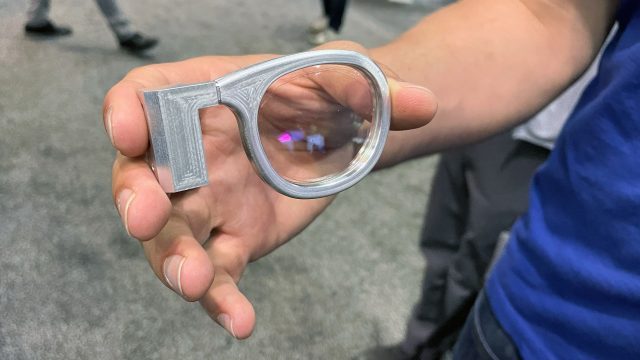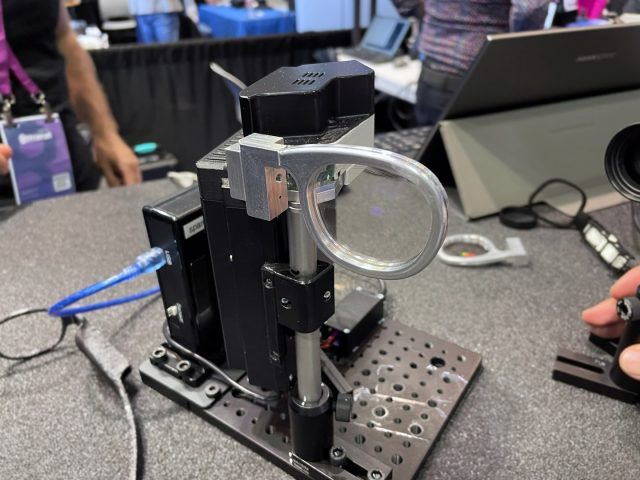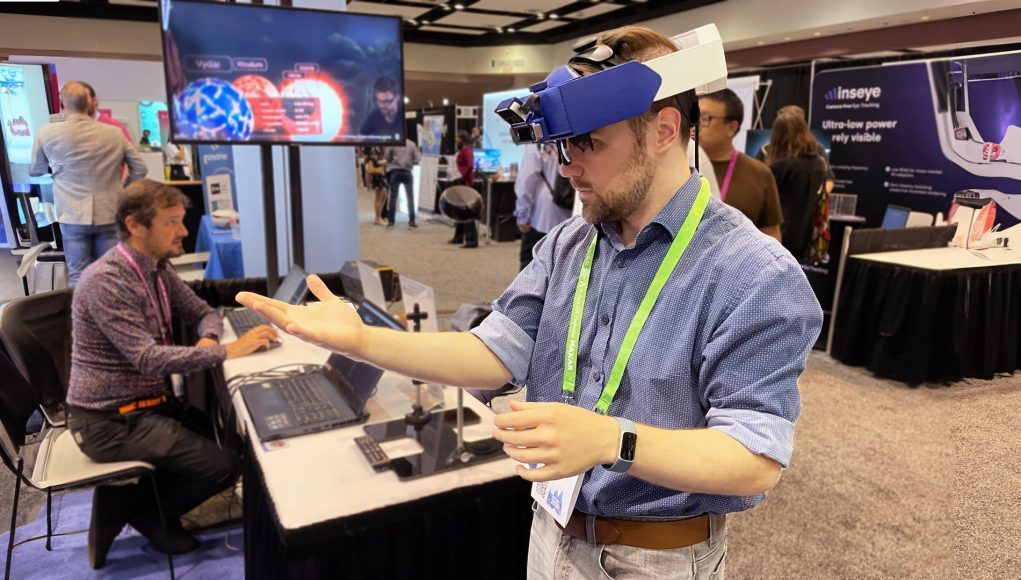A More Acceptable Form-factor

While the head-worn prototype I wore was compelling, it wasn’t the newest thing that Creal is showing. That headset provided a proof-of-concept for the light-field itself, but clearly used bulky hardware and optics that wouldn’t be suitable for fitting into a practical headset.
To that end the company is now showing off that it can make its light-field display work with any standard lens thanks to a holographic coating which acts as the ‘lens’ to get the virtual image into your eye.

This approach enables much more transparent lenses and fits a much more common glasses-sized form-factor—both of which are key for social acceptance which is a big deal for any head-worn device that is used outside the home. And further, Creal says the holographic coating can be applied to existing ophthalmic lenses, meaning a standard corrective glasses lens can form the basis of the display.
That’s a serious advantage considering that traditional ophthalmic lenses are already manufactured at scale, and are a known quantity in terms of cost, durability, social acceptability, etc.
Challenges Remain
But Creal’s light-field display still has some drawbacks compared to the conventional displays seen in other headsets today.
For one, the resolution isn’t as good as what’s been achieved with displays in other headsets. Creal says its tech can achieve higher resolution, but what it’s managed to demo so far isn’t as sharp as contemporary headsets on the market today, let alone next-gen devices poised to launch. Further, the system struggles to achieve an acceptably wide color gamut, giving images a somewhat washed-out look.
Granted, the company has been continuously improving nearly every aspect of the system’s performance over the years, and it believes there’s still significant improvements to be made as it refines its methods, components, and calibrations.
Creal has been transparent about its performance goals; here’s where the company claims it is today and where it thinks its tech can get to by 2025:
| (per eye) | 2023 | 2025+ |
| Angular resolution at infinity | 40 PPD | 50 ppd |
| Modulator resolution | 1 Mpix | 1+ Mpix |
| Depth resolution | Continuous | Continuous |
| FoV (diagonal) | 36° | 60° (light-field: 20-30°) |
| Effective eyebox (exit pupil) | 13 mm (6 mm) |
16 mm (10 mm) |
| Eye relief | 20 ± 3 mm | 20 mm |
| Colors | 2 M | ~10 million |
| Rendering load (equivalent to flat image) |
HD | n/a (on chip) |
| Frame rate | 160 Hz | Up to 240 Hz |
| Sub-frame rate | 6.5 kHz | 8 kHz |
| Brightness | 2000 nits | Up to 7000 nits |
| Contrast | 1 000/1 | 10 000/1 |
| Combiner type | Holographic, prescription compatible | Holographic, prescription compatible |
| Transparency | 91% | 97% |
| Power consumption | 800 mW | ~100 mW |
| Volume module (LF. engine) | 7 cm3 | 2 cm3 |
Field-of-view, however, is perhaps the system’s biggest challenge. As you can see in the specs above, although Creal expects to achieve a 60° (per-eye) FoV, only 20-30° will be a genuine light-field. The rest can be filled out with non-light-field imagery to expand the overall view, but the outer portion won’t have the same light-field benefits as the center part.
However, our eyes are rarely pointed directly ahead. Instead they regularly swivel off-axis to look at things during regular day-to-day life (and when glancing around a virtual scene). Without having the light-field cover a more significant portion of the field-of-view, this defeats some of the benefit of the display.
Creal has said it hopes to overcome this issue with ‘pupil steering’ (also known as dynamic foveated display), which would track the user’s eye and move the light-field portion of the view to make sure it’s always at the center of your gaze. However, this is another significant technical challenge for the industry at large, and one that I’ve yet to see sufficiently solved in a form-factor that would work in a glasses-sized product.
Still, it’s exciting to see a company working hard on this challenge that others seem to be leaving untouched, so we’ll continue to keep our eyes on Creal.







